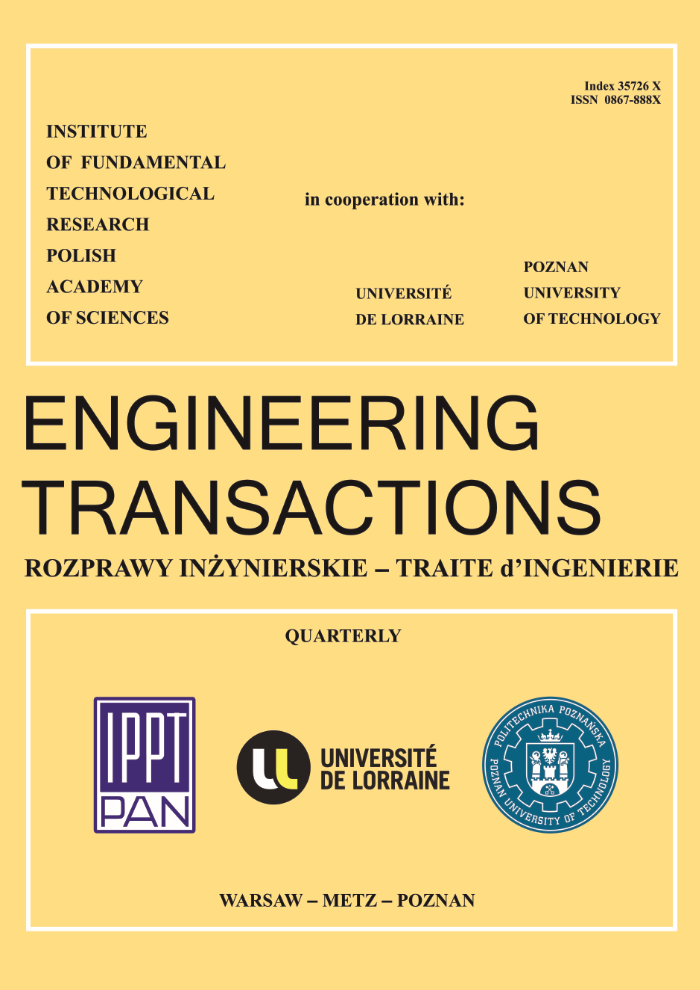Zagadnienie Rozchodzenia się Fal w Nieograniczonym Ośrodku Lepkosprężystym przy Uwzględnieniu Sprzężenia Termomechanicznego
Abstract
The wave mentioned in the title is produced by a plane harmonic source of heat. The Kelvin-Voigt and Maxwell body are considered. Equations are obtained for both determining the phase velocity c and the damping coefficient δ in function of the dimensionless coordinate ϱ0 = ωx/c2. In the case of the Kelvin-Voigt model approximate values of c and δ are obtained for ϱ0 « 1. It is found that the wave velocity does not differ, in this case, from the corresponding value in the case of an elastic body with coupling. The damping coefficient depends on the creep time t1. For the Maxwell model no approximate values for c and δ have been obtained for ϱ0 « 1 without previous assumption of the relaxation time t0.References
1. A.M. FREUDENTHAL, H. GEIRINGER, The Mathematical Theories of the Inelastic Continuum, Springer-Verlag 1958.
2. D. R. BLAND, The Theory of Linear Viscoelasticity, Pergamon Press, 1960.
3. S. C. HUNTER, Progress in Solid Mechanics, North-Holland Publ. Comp., Amsterdam 1960.
4. P. CHADWICK, I. N. SNEDDON, Plane waves in an elastic solid conducting heat, J. Mech. Phys. Solids, 6 (1958).
5. S.C. HUNTER, Tentative equations for the propagation of stress, strain and temperature fields in viscoelastic solid, J. Mech. Phys. Solids, 9 (1961).
6. W. NOWACKI, Zagadnienia termosprężystości, PWN, Warszawa 1960.
7. B. A. BOLEY, J. H. WEINER, Theory of Thermal Stresses, New York-London 1960,
8. J. STEFANIAK, Fale Rayleigha w ciałach lepkosprężystych przy uwzględnieniu sprzężenia termomechanicznego, Poznańskie Towarzystwo Przyjaciół Nauk, 1965.
2. D. R. BLAND, The Theory of Linear Viscoelasticity, Pergamon Press, 1960.
3. S. C. HUNTER, Progress in Solid Mechanics, North-Holland Publ. Comp., Amsterdam 1960.
4. P. CHADWICK, I. N. SNEDDON, Plane waves in an elastic solid conducting heat, J. Mech. Phys. Solids, 6 (1958).
5. S.C. HUNTER, Tentative equations for the propagation of stress, strain and temperature fields in viscoelastic solid, J. Mech. Phys. Solids, 9 (1961).
6. W. NOWACKI, Zagadnienia termosprężystości, PWN, Warszawa 1960.
7. B. A. BOLEY, J. H. WEINER, Theory of Thermal Stresses, New York-London 1960,
8. J. STEFANIAK, Fale Rayleigha w ciałach lepkosprężystych przy uwzględnieniu sprzężenia termomechanicznego, Poznańskie Towarzystwo Przyjaciół Nauk, 1965.


